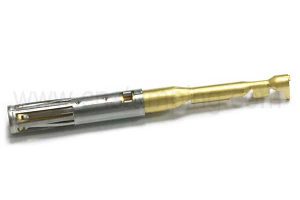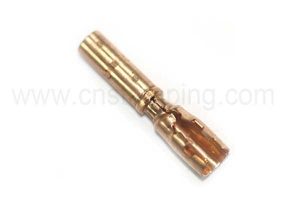Development Trend of Automotive Connectors
Automotive connectors are sockets used for powering electronic devices, transmitting data, or connecting external devices in cars. They play a vital role in modern cars, not only simplifying the way people interact with cars but also expanding the boundaries of car functions and improving the driving experience.
Function of Automotive Connectors
The main function of automotive connectors is to build a bridge of communication between blocked or isolated circuits in the circuit so that the current can flow so that the circuit can achieve the intended function. They realize power supply, data transmission and signal control by connecting electronic devices inside the car and external devices (such as charging devices, music players, navigation systems, etc.).
Composition of Automotive Connectors

Automotive connectors are mainly composed of four basic structural components:
- Contacts
Connector Contacts are the core parts of automotive connectors to complete the electrical connection function. Generally, they are composed of a positive contact (such as a round pin, a square pin or a plug) and a negative contact (i.e., a socket) to form a contact pair, and the electrical connection is completed by plugging in.
- Shells
Also known as the shell, it provides mechanical protection for the built-in insulating mounting plate and pins. And it also provides alignment when the plug and socket are plugged in, thereby fixing the connector to the device.
- Insulator
It arranges the contacts in the required position and spacing and ensures the insulation performance between the contacts and between the contacts and the shell.
- Accessories
May include additional components for fixing, protecting or enhancing the performance of the connector.
Application Scenarios of Automotive Connectors
Automotive connectors are widely used in various scenarios, including but not limited to:
- Power supply interface: used to charge portable devices such as mobile phones and tablets.
- Data transmission interface: connects the car with external devices (such as computers) for data transmission.
- Control system interface: connects various control systems of the car (such as navigation system and audio system) to achieve functional control.
- Vehicle diagnostic interface: connects the car with the diagnostic instrument. Obtains various data about the vehicle and analyzes it, helping the owner understand the vehicle’s condition and perform timely maintenance.
Development Trend of Automotive Connectors
The future development direction of automotive connectors will be affected by the overall trend of the automotive industry, technological progress, and changes in market demand. The following are several major development directions:
Intelligence and high-speed
With the development of automotive intelligence, the continuous maturity of autonomous driving and vehicle networking technologies. The amount of data that needs to be transmitted inside the car has increased dramatically. Therefore, automotive connectors will develop in the direction of high speed and high frequency to meet the needs of in-vehicle infotainment systems, navigation systems, autonomous driving systems, etc., for high-speed and stable data transmission. High-speed connectors will be able to support higher data transmission rates and lower signal attenuation to ensure the normal operation of onboard electronic equipment.
Electrification and high voltage
The popularity of new energy vehicles has promoted the process of automotive electrification. And high-voltage electrical systems have become an important part of new energy vehicles. Therefore, automotive connectors will develop in the direction of high voltage to meet the needs of new energy vehicles for high voltage and high current transmission. High-voltage connectors need to have higher pressure resistance and lower resistivity to ensure the stability and safety of current transmission.
Lightweight and miniaturization
With the advancement of lightweight design of automotive, connector also need to develop in the direction of lightweight and miniaturization. Lightweight design can reduce the overall weight of the car, improve fuel economy or extend the range of electric vehicles. Miniaturization design can save space and make the interior layout of the car more compact. Therefore, in the future, automotive connectors will adopt lighter materials and more compact structural designs.
Standardization and modularization
Standardization and modularization are one of the important trends in the development of automotive connectors. By formulating unified connector standards and modular designs, production costs can be reduced, production efficiency can be improved. And interchange and maintenance between different models can be facilitated. In addition, standardization and modularization will also help promote the global procurement and supply chain integration of automotive connectors.
Safety and reliability
With the continuous advancement of automotive technology and the improvement of consumer requirements for automotive safety performance, the safety and reliability of automotive connectors will also become an important development direction. In the future, automotive connectors will adopt more advanced materials and processes, in order to improve the product’s high-temperature resistance, corrosion resistance, wear resistance and other properties to ensure stable connection and transmission performance even in harsh environments.
Environmental protection and sustainable development
Environmental protection and sustainable development are one of the important considerations for the development of automotive connectors in the future. With the increasing global awareness of environmental protection and the improvement of regulations, the production and use of automotive connectors will pay more attention to environmental protection and sustainability. For example, the use of recyclable materials. The reduction of the use of harmful substances. And the reduction of energy consumption and emissions in the production process.
Conclusion
In the future, automotive connectors will develop in the direction of intelligence, high speed, electrification, high voltage, lightweight, miniaturization, standardization, modularization, environmental protection and sustainable development. These trends will promote the continuous advancement and innovation of automotive connector technology. And provide more reliable and efficient connection solutions for the development of the automotive industry.
